Navigation/Menü: Links auf weitere Seiten dieser Website und Banner
08.12.2004
HRSC Press Release #138 - Reull Vallis (orbit 0451)
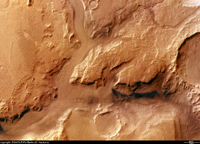 Am 29. Mai 2004 nahm die hochauflösende Stereokamera (HRSC) auf der ESA Sonde
Mars Express im Orbit 451 den Zentralbereich des Tales Reull Vallis mit einer
Auflösung von etwa 21 Metern pro Bildpunkt auf. Die Abbildungen zeigen hiervon
einen Ausschnitt bei 42° südlicher Breite und 103° östlicher Länge.
Am 29. Mai 2004 nahm die hochauflösende Stereokamera (HRSC) auf der ESA Sonde
Mars Express im Orbit 451 den Zentralbereich des Tales Reull Vallis mit einer
Auflösung von etwa 21 Metern pro Bildpunkt auf. Die Abbildungen zeigen hiervon
einen Ausschnitt bei 42° südlicher Breite und 103° östlicher Länge.
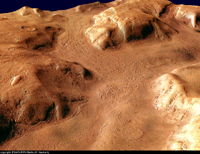 On 29 May 2004 the High-Resolution Stereo Camera (HRSC) onboard the ESA
spacecraft Mars Express obtained image data in orbit 451 with a ground
resolution of approximately 21 metres per pixel. The image was acquired in the
southern part of this orbit, at approximately 42° southern latitude and 102°
eastern longitude, and shows a region of Reull Vallis.
On 29 May 2004 the High-Resolution Stereo Camera (HRSC) onboard the ESA
spacecraft Mars Express obtained image data in orbit 451 with a ground
resolution of approximately 21 metres per pixel. The image was acquired in the
southern part of this orbit, at approximately 42° southern latitude and 102°
eastern longitude, and shows a region of Reull Vallis.
Reull Vallis is an outflow channel that extends 1500 km across Promethei Terra
in the direction of Hellas Basin. It is the major outflow channel in the region
and exhibits a high degree of primary surface modification, suggesting a complex
evolution.
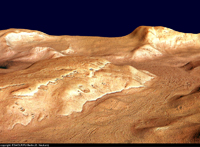 Die Bildszene zeigt den Zusammenfluß von Reull Vallis mit einem südlichen
Seitenarm. Reull Vallis ist ein Abflusstal, welches sich durch das Hochland von
Promethei Terra in Richtung des Hellasbeckens erstreckt. Es handelt sich um ein
großes, ausgeprägtes Abflusssystem, dessen Komplexität auf einen lange und
abwechslungsreiche Entwicklung hinweist. Das ungefähr 1500 Kilometer lange Tal
ist im abgebildeten Bereich bis zu 20 Kilometer breit, es hat sich bis zu 1800
Meter tief in die umgebende Ebene eingeschnitten.
Die Bildszene zeigt den Zusammenfluß von Reull Vallis mit einem südlichen
Seitenarm. Reull Vallis ist ein Abflusstal, welches sich durch das Hochland von
Promethei Terra in Richtung des Hellasbeckens erstreckt. Es handelt sich um ein
großes, ausgeprägtes Abflusssystem, dessen Komplexität auf einen lange und
abwechslungsreiche Entwicklung hinweist. Das ungefähr 1500 Kilometer lange Tal
ist im abgebildeten Bereich bis zu 20 Kilometer breit, es hat sich bis zu 1800
Meter tief in die umgebende Ebene eingeschnitten.
In den Aufnahmen sind zahlreiche Krater im Bereich der Talflanken zu erkennen,
die durch nachfolgende Transportprozesse aufgefüllt worden sind. In den Tälern
sieht man eine ausgeprägte parallele Struktur, die eventuell durch
gletscherartiges Fließen von lockerem Schutt in Verbindung mit Eis entstanden
ist. Einige am Talboden gelegene Krater wurden dadurch verfüllt. Derartige
Fließstrukturen sind auch in zahlreichen Einschlagkratern zu erkennen. In
Einzelfällen sind in diesen Bereichen isolierte, linsenartige Einbuchtungen zu
sehen, die eventuell durch Sublimation von Eis entstanden sind.
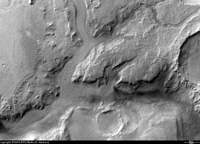 In these images, Reull Vallis extends from east to northwest and is connected to
a southern tributary. Reull Vallis has a width up to approximately 20 km and has
cut into the surrounding plain to a depth of 1800 meters. In the channels,
distinct parallel structures are visible, possibly caused by glacial flow of
loose debris mixed with ice. Small depressions, located on the flow features,
are probably caused by the sublimation of ice.
In these images, Reull Vallis extends from east to northwest and is connected to
a southern tributary. Reull Vallis has a width up to approximately 20 km and has
cut into the surrounding plain to a depth of 1800 meters. In the channels,
distinct parallel structures are visible, possibly caused by glacial flow of
loose debris mixed with ice. Small depressions, located on the flow features,
are probably caused by the sublimation of ice.
Numerous impact craters, visible on the flanks of the valley, have been filled
with material from these flows. Distinct flow features can be recognized within
impact craters, for example, the 15 km wide crater in the west of the image.
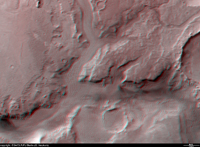 Die meisten Geländeformen in diesem Gebiet sind gerundet, lediglich jüngere
Formen heben sich deutlich durch ihre schärfer ausgeprägte Morphologie ab.
Auffällig ist auch der morphologische Unterschied zwischen der wenig erodierten
Ebene im Nordosten und den stark abgetragenen Gebieten südöstlich davon.
Die meisten Geländeformen in diesem Gebiet sind gerundet, lediglich jüngere
Formen heben sich deutlich durch ihre schärfer ausgeprägte Morphologie ab.
Auffällig ist auch der morphologische Unterschied zwischen der wenig erodierten
Ebene im Nordosten und den stark abgetragenen Gebieten südöstlich davon.
Am südlichen und westlichen Rand der Bildszene lassen sich größere Krater
erkennen. Diese haben Durchmesser zwischen 15 und 35 Kilometern. Alle Krater
weisen stark erodierte Ränder auf und sind teils verfüllt. Diese Erosion hat
deutlich ausgeprägte, verzweigte Rinnensysteme am Rand des südlichen Kraters
hinterlassen.
There is a clear morphological distinction between the heavily eroded southwest
and the plains of the northeast, which have experienced much less erosion. While
most landforms throughout the image have a rounded, softened appearance, younger
structures have a distinctly sharp and raised morphology.
On the south and west edge of the color image, large impact craters are visible.
Their diameters range from 15 to 35 km. These craters have heavily eroded rims
and are partly filled with material. Erosion has left distinct, branched gully
systems at the edge of the large crater that is located on the southern edge of
the image.
Die Farbansichten wurden aus dem senkrecht blickenden Nadirkanal und den Farbkanälen erstellt, die Schrägansicht wurde aus den Stereokanälen der HRSC berechnet. Die Anaglyphen werden aus dem Nadirkanal und einem Stereokanal abgeleitet. Die schwarzweißen Detailaufnahmen wurden dem Nadirkanal entnommen, der von allen Kanälen die höchste Auflösung zur Verfügung stellt.
The colour scenes have been derived from the three HRSC-colour channels and the nadir channel. The perspective views have been calculated from the digital terrain model derived from the stereo channels. The anaglyph image was calculated from the nadir and one stereo channel. The black and white high resolution images were derived form the nadir channel which provides the highest detail of all channels.
Das Kameraexperiment HRSC auf der Mission Mars Express der Europäischen Weltraumorganisation ESA wird vom Principal Investigator Prof. Dr. Gerhard Neukum (Freie Universität Berlin), der auch die technische Konzeption der hochauflösenden Stereokamera entworfen hatte, geleitet. Das Wissenschaftsteam besteht aus 40 Co-Investigatoren aus 33 Institutionen und zehn Nationen. Die Kamera wurde am Deutschen Zentrum für Luft- und Raumfahrt (DLR) unter der Leitung des Principal Investigators (PI) G. Neukum entwickelt und in Kooperation mit industriellen Partnern gebaut (EADS Astrium, Lewicki Microelectronic GmbH und Jena -Optronik GmbH). Sie wird vom DLR -Institut für Planetenforschung in Berlin-Adlershof betrieben. Die systematische Prozessierung der Daten erfolgt am DLR. Die Darstellungen wurden vom Institut für Geologische Wissenschaften der FU Berlin in Zusammenarbeit mit dem DLR-Institut für Planetenforschung erstellt.
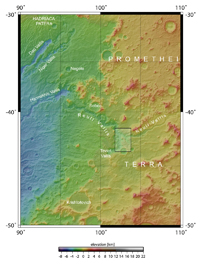 The High Resolution Stereo Camera (HRSC) experiment on the ESA Mars Express Mission is led by the
Principal Investigator (PI) Prof. Dr. Gerhard Neukum who also designed the camera technically. The
science team of the experiment consists of 40 Co-Investigators from 33 institutions and 10 nations.
The camera was developed at the German
Aerospace Center (DLR) under
the leadership of the PI G. Neukum and built in cooperation with industrial partners (EADS
Astrium, Lewicki Microelectronic GmbH and Jena-Optronik GmbH). The experiment on Mars Express
is operated by the DLR Institute of Planetary Research, through ESA/ESOC. The systematic
processing of the HRSC image data is carried out at DLR. The scenes shown here were created
by the PI-group at the Institute for Geological Sciences of the Freie Universitaet Berlin in
cooperation with the German Aerospace Center (DLR), Institute of Planetary Research, Berlin.
The High Resolution Stereo Camera (HRSC) experiment on the ESA Mars Express Mission is led by the
Principal Investigator (PI) Prof. Dr. Gerhard Neukum who also designed the camera technically. The
science team of the experiment consists of 40 Co-Investigators from 33 institutions and 10 nations.
The camera was developed at the German
Aerospace Center (DLR) under
the leadership of the PI G. Neukum and built in cooperation with industrial partners (EADS
Astrium, Lewicki Microelectronic GmbH and Jena-Optronik GmbH). The experiment on Mars Express
is operated by the DLR Institute of Planetary Research, through ESA/ESOC. The systematic
processing of the HRSC image data is carried out at DLR. The scenes shown here were created
by the PI-group at the Institute for Geological Sciences of the Freie Universitaet Berlin in
cooperation with the German Aerospace Center (DLR), Institute of Planetary Research, Berlin.
© Copyright: ESA/DLR/FU Berlin (G. Neukum)
Download
hochaufgelöste Bilddaten / full resolution image data
| Kontextkarte (MOLA) / Context Map (MOLA) | download TIF ( 4.8 MBs ) |
| Nadiraufnahme / Grayscale Nadir Image | download TIF ( 17.1 MBs ) |
| RGB Farbbild / RGB Colour Image | download TIF ( 51.4 MBs ) |
| Rot-Cyan Anaglyphe / Red-cyan anaglyphe | download TIF ( 52.5 MBs ) |
| Perspektive / Perspective view | download TIF ( 54.9 MBs ) |
| Perspektive #2 / Perspective view #2 | download TIF ( 52.5 MBs ) |

 Deutsch
Deutsch

